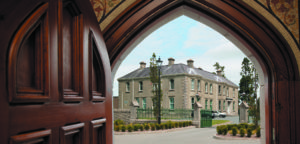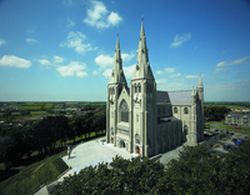CENTENARY OF THE CHURCH OF OUR LADY OF THE ASSUMPTION
TULLYALLEN
HOMILY BY ARCHBISOP SEÁN BRADY
SUNDAY 20 MAY 2001
As early as last November this parish decided they were going to celebrate the centenary of this beautiful Church of Our Lady of the Assumption in May of this year. This was a very appropriate date. Holy Mass was celebrated in this Church, for the first time, in the month of May 1991. That is 100 years ago. Of course May is the month of Our Lady.
To mark the occasion of the year of the Great Jubilee, which has just ended, Father Caraher and his Committee, decided to add a new spire to the Church. An architect drawing of the front of the Church, dating from 1901 contains a spire. However, it was not included in the actual building but you, the parishioners of the year 2001 have rectified that omission. Today we also bless in addition to the parish cemetery, the furnishings of the Church, a beautiful hand-woven piece, which is by a parishioner. All of this is a cause for great rejoicing and celebration and congratulations.
I am delighted that for this glorious occasion we have fine weather and have been joined by a number of people who have long associations with this parish, in one way or another. The Abbot of new Mellifont, Dom Bernard Boyle, is most welcome. His presence reminds us of the monastic history of this parish. That history goes back a long way. The historians tell us that there was a monastery in Tullyallen, founded by St. Colman. St. Colman is said to have died in 726. His monastery continued in existence for over 400 years. Then in the 12th century St. Malachy of Armagh undertook his famous renewal of the Irish Church.
Part of that initiative was the renewal of monastic life and the introduction of Cistercian monks to Old Mellifont in the year 1142. This came about because of St. Malachy’s friendship with St. Bernard of Clairvaux in France. In fact St. Malachy died in Clairvaux during one of his visits to St. Bernard, but not before he had already received the great gift of a monastic Cistercian presence and foundation for Mellifont. The first Abbot was Christban O’Comairde and he also became the first Parish Priest of the new Mellifont parish. That parish stretched over a wide area – from the Mattock to the Boyne and east as far as where the new motorway is going. St. Bernard and St. Christban are featured in the lovely stained glass window behind the altar of this Church. That window bears testimony to the appreciation and awareness of the immense contribution made by the Cistercian monks to this parish and indeed to the diocese over the last 1,000 years. We owe them a great debt. That Cistercian link continued until the suppression of Mellifont Monastery in 1539 by King Henry VIII. In fact the link continued on after the suppression. The Monastery was dissolved but individual Cistercian priests were determined not to abandon their people but to serve them, as best they could, in the face of immense difficulties. We know that Father John McCabe, Parish Priest here from 1718-1744 was a Cistercian.
From a very cursory study, it appears to me that the history of this parish has been marked by outstanding generosity. This perhaps is also a legacy of the marks, which the Cistercians have left on the parish. This is not surprising since they were themselves men who had left all things to follow Christ.
Father Thomas Treanor, Parish Priest from 1821-1870, purchased a farm from his own resources and then left it to the parish for the benefit of his successors. When Father Matthew Kearney was organising the building of a Parochial House in 1868, the parishioners gave their labour free and made the bricks in the field, which became to be known as the ‘Brick Field’.
Father Thomas Taaffe became Parish Priest in 1884. He set about the provision of a new Church and cemetery. We are told that he bought two gardens from Thomas and Mary Caulfield. A price was agreed but never accepted – yet another example of heroic generosity. The architect for the new Church was William Byrne of Dublin and the Contractor was James Wynne of Dundalk. The foundation stone was laid by Cardinal Logue on Low Sunday, 1898. Later that day Benediction was given in the ruins of Mellifont Abbey Church for the first time in 359 years. Father Taaffe was in failing health. His dearest wish and prayer were that he should live to celebrate Mass in the new Church. The Lord heard his prayer and granted him his wish. The first Mass in the new Church, celebrated in May 1901, was Father Taaffe’s last public Mass. We are very pleased to welcome Father Denis Nulty, PP, St. Mary’s, Drogheda, a grandnephew of the late Father Taaffe.
As regards the history of the last 100 years and of this Church, you will have your own ideas and memories and much clearer ones than any I can give you. No doubt they are memories of joyful days, like days of Baptism and First Communion, Confirmation and Marriages. Of course the ordination of Father Malachy Finnegan, SMA, must have been one of the highlights, and it is great that he can be with us today also. There were other days, less joyful, such as days of funerals and month memories and anniversary Masses. They were days tinged with sorrow and grief when you came here to get some ray of hope in the midst of despair and discouragement.
You came to hear the Word of God and to get the strength to keep that Word. You came, because you believe what we heard Jesus say just now, in the Gospel.
“If anyone loves me he will keep my word,
and my Father will love him,
and we shall come to him
and make our home with him.”
Those words make clear to me why people decide to build themselves a Church – so that they may have a place where they can gather to hear the word of Jesus, which is also the word of God the Father. It is where they can get the strength to respond to that love in word and deed. In that way they become the kind of person, where God the Father and God the Son, can come and make their homes the Temples of God.
People build themselves a Church where the Advocate – the Holy Spirit, the Spirit of the Risen Christ – can come to them and to their children, especially on Confirmation day, to teach them what is truly wise and to remind them of what Jesus said and did.
A parish builds itself a Church where it can gather in times of trouble and of great fear, to find peace and reassurance. When Foot and Mouth threatened in the Cooley Peninsula and in South Armagh, people felt a great need to come together and pray and implore God’s protection and peace. When there is the threat of tragedy or where tragedy has taken place, the power of prayer, to dissolve fear and worry is very reassuring.
Over the last 100 years people often came here, burdened with the weight of sin, bowed down with the shame of guilt. They came to find pardon and peace. How often people came here who had been hurt and who were in pain, who were aching. They came to find healing and consolation in the sacrament of Confession. I firmly believe that we have not thought or reflected enough on that wonderful promise which Jesus made in today’s Gospel –
“Peace I bequeath to you,
my own peace I give you,
a peace the world cannot give this is my gift to you.
Do not let your hearts be troubled or afraid”.
When we sin we hurt ourselves. We do indeed let our hearts be troubled. We are afraid of judgement and loss of everlasting happiness. When we sin, we injure and damage our relationship with God. All of that needs healing and forgiveness and pardon and peace.
We all desire peace from the depth of our hearts. We all hope for true peace. That is, we hope to live in harmony with nature and with our neighbour, with ourselves and with God. But, when we sin we disrupt that harmony. We are not at peace.
The great hope for peace became a reality in Jesus Christ. He has conquered sin. Sin has been conquered by him and in him. Jesus saw that his disciples were saddened at the prospect of his leaving them. He stepped in to reassure them. “My peace I leave you” he said, “My peace I give onto to you”. This peace is not linked to his bodily, physical presence among us. It is the result of his victory. By rising from the dead, Jesus shows that he is stronger than death. On the night of the Last Supper he told his friends, not to fear the evil world which will persecute them out of hatred. “Have confidence, it is the world that I have conquered”. Along with this peace Jesus gives us the Holy Spirit and power over sin.
After his resurrection St. John tells us that Jesus came and stood among his disciples and said, “Peace by with you”. After he had said this he showed them his hands and his side. Then the disciples rejoiced when they saw the Lord – Jesus said to them again, “Peace be with you. As the Father has sent me, I send you”. When he had said this he breathed on them and said to them, “Receive the Holy Spirit. If you forgive the sins of any, they are forgiven them. If you retain the sins of any, they are retained”. That is the road to true peace. There is no other road to true peace. By receiving the Holy Spirit, by accepting the forgiveness offered to us, and by offering forgiveness to those who have offended us, we receive peace.
This beautiful Church was dedicated to Our Lady of the Assumption. That was 49 years before Pope Pius XII solemnly defined it as an article of our faith that Mary was assumed, body and soul, into heaven. It was a prophetic decision by Father Taaffe and his mentors. Obviously that decision was inspired by the wish to ask the help of Our Lady. Where she has gone, we all hope to follow. We will follow Our Lady to heaven but only if we unite ourselves to her Son, Jesus Christ. Only if we remove and get forgiveness for the sins we have committed.
Today in the adjoining parish of St. Peter’s, Drogheda, the relics of St. Thérèse of Lisieux have arrived. As she lay dying, the Little Flower said, “I am not dying, I am entering into life”. Later on she said, “I do not regret, not for a single moment do I regret, having offered myself to love”. Her last words were, “Oh, how I love Him. Oh my God, I love you”.
On another occasion she said, “One never expects too much of God; one receives as much from Him as one hopes for”. Then she said, “One demands of God exactly as much as one expects from Him” for there is nothing that Thérèse would not expect of God’s love.
This suggests one last thought to me – I am told that there has only been one ordination to the priesthood ever in this Church. I find that truly amazing. We all know that the Church needs priests to celebrate and lead all those activities, which we described as taking place in any parish church. Perhaps, as in several other parishes, you presume that there would always be a supply from places like Tallanstown, native parish of Father Caraher and from Coalisland, the native parish of Father O’Kelly. Of course we never miss the shelter until the tree falls, nor the water until the spring begins to run dry. Well the spring has not run dry, thank God, we have eleven seminarians, two of whom will be ordained this summer, please God. Well the supply has become a little less abundant, and so I ask you, I appeal to you, to pray for vocations to priesthood and religious life. Why should there not be vocations like that from this parish? Please, parents, speak to you children about the possibility that God is calling them, not in any forceful way, but in a loving way, in a caring way for them, because if that is what God wants them to do, then help them to carry it out. Remember St Thérèse’s words, “one demands of God exactly as much as one expects from Him”.



You must be logged in to post a comment.